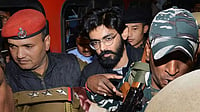The Indian Space Research Organisation (ISRO) on Sunday said that Chandrayaan-3 has sent its first observations from the South Pole of the Moon.
The Vikram lander and Pragyaan rover of Chandrayaan-3 are have six equipments for a range of scientific activities. Their mission would last for 14-Earth days.
The ISRO on Sunday shared the first observations from the Chandra's Surface Thermophysical Experiment (ChaSTE) payload carried by Vikram lander. The purpose of ChaSTE is to carry out the measurements of thermal properties of the Moon's surface near the polar region. The payload has been developed by Space Physics Laboratory (SPL), Vikram Sarabhai Space Centre in collaboration with Physical Research Laboratory (PRL), Ahmedabad.
Sharing a graph showing ChaSTE's observations, ISRO noted on Twitter that it is the first such profile for Moon's South Pole. Notably, Chandrayaan-3 is the first spacecraft ever to land on the South Pole of Moon. The South Pole is the shadowy, unexplored region of the Moon that's the focus of upcoming key missions, including Artemis-III of the United States that would take humans to the Moon for the first time in five decades. In 2009, Chandrayaan-1 through a US instrument had confirmed the presence of ice on Moon's South Pole. The presence of ice has led to to possibility of water in the region that could make life sustainable on Moon.
In a tweet, ISRO said, "ChaSTE (Chandra's Surface Thermophysical Experiment) measures the temperature profile of the lunar topsoil around the pole to understand the thermal behaviour of the moon's surface. It has a temperature probe equipped with a controlled penetration mechanism capable of reaching a depth of 10 cm beneath the surface. The probe is fitted with 10 individual temperature sensors.
"The presented graph illustrates the temperature variations of the lunar surface/near-surface at various depths, as recorded during the probe's penetration. This is the first such profile for the lunar south pole. Detailed observations are underway."
The findings of Chandrayaan-3 are set to be studied keenly by all the space agencies as these are the first observations from the unexplored South Pole region.
Besides ChaSTE, the other payloads carried by Vikram lander and Pragyaan rover are:
1. Radio Anatomy of Moon Bound Hypersensitive ionosphere and Atmosphere (RAMBHA) Langmuir probe (LP): To measure the near surface plasma (ions and electrons) density and its changes with time.
2. Instrument for Lunar Seismic Activity (ILSA): To measure seismicity around the landing site and delineate the structure of the Lunar crust and mantle.
3. LASER Retroreflector Array (LRA): It is a passive experiment to understand the dynamics of the Moon system.
4. LASER Induced Breakdown Spectroscope (LIBS): Qualitative and quantitative elemental analysis and to derive the chemical composition and infer mineralogical composition to further our understanding of Lunar-surface.
5. Alpha Particle X-ray Spectrometer (APXS): To determine the elemental composition of the Moon’s soil and rocks around the Lunar landing site.
The propulsion module that took the landing module comprising Vikram and Pragyaan also carries the Spectro-polarimetry of Habitable Planet Earth (SHAPE) payload that would look into the future discoveries of smaller planets in reflected light would allow us to probe into a variety of exoplanets which would qualify for habitability (or for presence of life).
In 2025, ISRO and Japan Aerospace Exploration Agency (JEXA) are set to launch Lunar Polar Exploration mission called LUPEX that would look for the presence of water on the polar regions of Moon. Under the LUPEX mission, a Japanese rocket would carry an Indian lander and a Japanese rover to Moon.


























